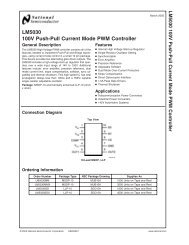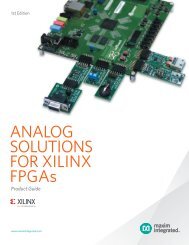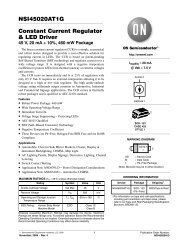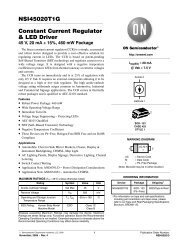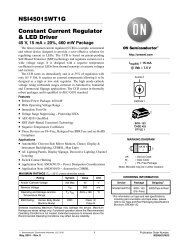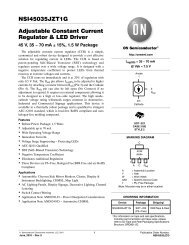NSI45025 - CCR & LED Driver - Silica
NSI45025 - CCR & LED Driver - Silica
NSI45025 - CCR & LED Driver - Silica
Create successful ePaper yourself
Turn your PDF publications into a flip-book with our unique Google optimized e-Paper software.
<strong>NSI45025</strong>T1G<br />
ELECTRICAL CHARACTERISTICS (TA = 25°C unless otherwise noted)<br />
Characteristic Symbol Min Typ Max Unit<br />
Steady State Current @ Vak = 7.5 V (Note 1) Ireg(SS) 21.25 25 28.75 mA<br />
Voltage Overhead (Note 2) Voverhead 1.8 V<br />
Pulse Current @ Vak = 7.5 V (Note 3) Ireg(P) 24.4 29.4 34.5 mA<br />
Capacitance @ Vak = 7.5 V (Note 4) C 2.5 pF<br />
Capacitance @ Vak = 0 V (Note 4) C 5.7 pF<br />
1. Ireg(SS) steady state is the voltage (Vak) applied for a time duration ≥ 10 sec, using FR−4 @ 300 mm2 1 oz. Copper traces, in still air.<br />
2. Voverhead = Vin − V<strong>LED</strong>s. Voverhead is typical value for 80% Ireg(SS). 3. Ireg(P) non−repetitive pulse test. Pulse width t ≤ 300 sec.<br />
4. f = 1 MHz, 0.02 V RMS.<br />
THERMAL CHARACTERISTICS<br />
Total Device Dissipation (Note 5) T A = 25°C<br />
Derate above 25°C<br />
Characteristic Symbol Max Unit<br />
http://onsemi.com<br />
2<br />
P D<br />
208<br />
1.66<br />
mW<br />
mW/°C<br />
Thermal Resistance, Junction−to−Ambient (Note 5) RθJA 600 °C/W<br />
Thermal Reference, Lead−to−Ambient (Note 5) RψLA 404 °C/W<br />
Thermal Reference, Junction−to−Cathode Lead (Note 5) RψJL 196 °C/W<br />
Total Device Dissipation (Note 6) T A = 25°C<br />
Derate above 25°C<br />
P D<br />
227<br />
1.8<br />
mW<br />
mW/°C<br />
Thermal Resistance, Junction−to−Ambient (Note 6) RθJA 550 °C/W<br />
Thermal Reference, Lead−to−Ambient (Note 6) RψLA 390 °C/W<br />
Thermal Reference, Junction−to−Cathode Lead (Note 6) RψJL 160 °C/W<br />
Total Device Dissipation (Note 7) T A = 25°C<br />
Derate above 25°C<br />
P D<br />
347<br />
2.8<br />
mW<br />
mW/°C<br />
Thermal Resistance, Junction−to−Ambient (Note 7) RθJA 360 °C/W<br />
Thermal Reference, Lead−to−Ambient (Note 7) RψLA 200 °C/W<br />
Thermal Reference, Junction−to−Cathode Lead (Note 7) RψJL 160 °C/W<br />
Total Device Dissipation (Note 8) T A = 25°C<br />
Derate above 25°C<br />
P D<br />
368<br />
2.9<br />
mW<br />
mW/°C<br />
Thermal Resistance, Junction−to−Ambient (Note 8) RθJA 340 °C/W<br />
Thermal Reference, Lead−to−Ambient (Note 8) RψLA 208 °C/W<br />
Thermal Reference, Junction−to−Cathode Lead (Note 8) RψJL 132 °C/W<br />
Total Device Dissipation (Note 9) T A = 25°C<br />
Derate above 25°C<br />
P D<br />
436<br />
3.5<br />
mW<br />
mW/°C<br />
Thermal Resistance, Junction−to−Ambient (Note 9) RθJA 287 °C/W<br />
Thermal Reference, Lead−to−Ambient (Note 9) RψLA 139 °C/W<br />
Thermal Reference, Junction−to−Cathode Lead (Note 9) RψJL 148 °C/W<br />
Total Device Dissipation (Note 10) T A = 25°C<br />
Derate above 25°C<br />
P D<br />
463<br />
3.7<br />
mW<br />
mW/°C<br />
Thermal Resistance, Junction−to−Ambient (Note 10) RθJA 270 °C/W<br />
Thermal Reference, Lead−to−Ambient (Note 10) RψLA 150 °C/W<br />
Thermal Reference, Junction−to−Cathode Lead (Note 10) RψJL 120 °C/W<br />
Junction and Storage Temperature Range T J, T stg −55 to +150 °C<br />
5. FR−4 @ 100 mm2 , 1 oz. copper traces, still air.<br />
6. FR−4 @ 100 mm2 , 2 oz. copper traces, still air.<br />
7. FR−4 @ 300 mm2 , 1 oz. copper traces, still air.<br />
8. FR−4 @ 300 mm2 , 2 oz. copper traces, still air.<br />
9. FR−4 @ 500 mm2 , 1 oz. copper traces, still air.<br />
10.FR−4 @ 500 mm2 , 2 oz. copper traces, still air.<br />
NOTE: Lead measurements are made by non−contact methods such as IR with treated surface to increase emissivity to 0.9.<br />
Lead temperature measurement by attaching a T/C may yield values as high as 30% higher °C/W values based upon empirical<br />
measurements and method of attachment.



